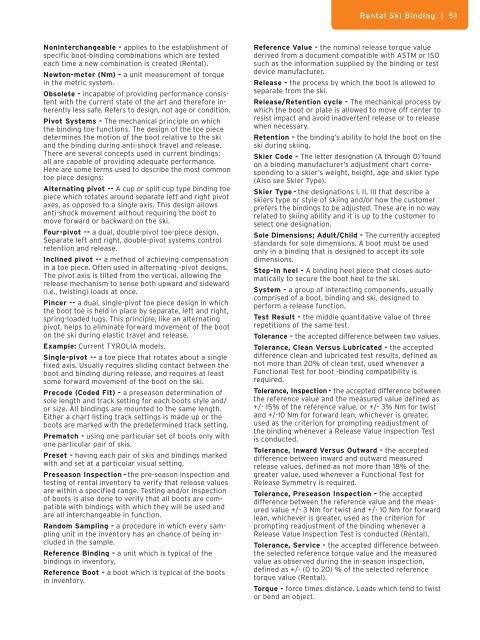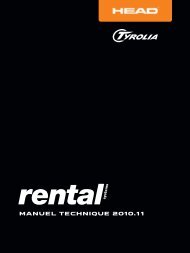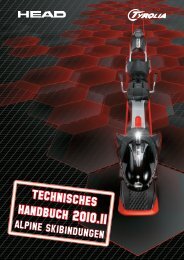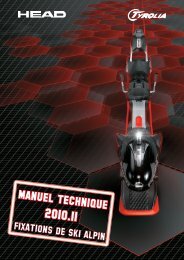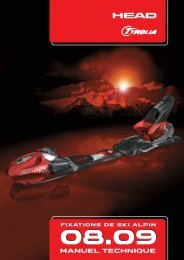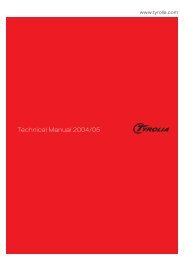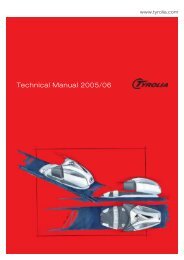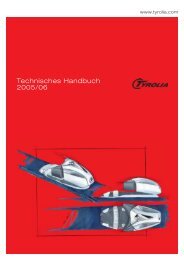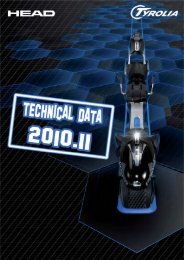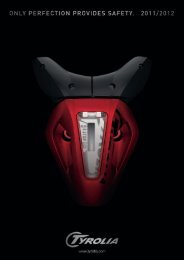Create successful ePaper yourself
Turn your PDF publications into a flip-book with our unique Google optimized e-Paper software.
Noninterchangeable - applies to the establishment of<br />
specific boot-binding combinations which are tested<br />
each time a new combination is created (Rental).<br />
Newton-meter (Nm) - a unit measurement of torque<br />
in the metric system.<br />
Obsolete - incapable of providing performance consistent<br />
with the current state of the art and therefore inherently<br />
less safe. Refers to design, not age or condition.<br />
Pivot Systems - The mechanical principle on which<br />
the binding toe functions. The design of the toe piece<br />
determines the motion of the boot relative to the ski<br />
and the binding during anti-shock travel and release.<br />
There are several concepts used in current bindings:<br />
all are capable of providing adequate performance.<br />
Here are some terms used to describe the most common<br />
toe piece designs:<br />
Alternating pivot -- A cup or split cup type binding toe<br />
piece which rotates around separate left and right pivot<br />
axes, as opposed to a single axis. This design allows<br />
anti-shock movement without requiring the boot to<br />
move forward or backward on the ski.<br />
Four-pivot -- a dual, double-pivot toe-piece design.<br />
Separate left and right, double-pivot systems control<br />
retention and release.<br />
Inclined pivot -- a method of achieving compensation<br />
in a toe piece. Often used in alternating -pivot designs.<br />
The pivot axis is tilted from the vertical, allowing the<br />
release mechanism to sense both upward and sideward<br />
(i.e., twisting) loads at once.<br />
Pincer -- a dual, single-pivot toe piece design in which<br />
the boot toe is held in place by separate, left and right,<br />
spring-loaded lugs. This principle, like an alternating<br />
pivot, helps to eliminate forward movement of the boot<br />
on the ski during elastic travel and release.<br />
Example: Current TYROLIA models.<br />
Single-pivot -- a toe piece that rotates about a single<br />
fixed axis. Usually requires sliding contact between the<br />
boot and binding during release, and requires at least<br />
some forward movement of the boot on the ski.<br />
Precode (Coded Fit) - a preseason determination of<br />
sole length and track setting for each boots style and/<br />
or size. All bindings are mounted to the same length.<br />
Either a chart listing track settings is made up or the<br />
boots are marked with the predetermined track setting.<br />
Prematch - using one particular set of boots only with<br />
one particular pair of skis.<br />
Preset - having each pair of skis and bindings marked<br />
with and set at a particular visual setting.<br />
Preseason Inspection - the pre-season inspection and<br />
testing of rental inventory to verify that release values<br />
are within a specified range. Testing and/or inspection<br />
of boots is also done to verify that all boots are compatible<br />
with bindings with which they will be used and<br />
are all interchangeable in function.<br />
Random Sampling - a procedure in which every sampling<br />
unit in the inventory has an chance of being included<br />
in the sample.<br />
Reference Binding - a unit which is typical of the<br />
bindings in inventory.<br />
Reference Boot - a boot which is typical of the boots<br />
in inventory.<br />
Rental Ski Binding | 51<br />
Reference Value - the nominal release torque value<br />
derived from a document compatible with ASTM or ISO<br />
such as the information supplied by the binding or test<br />
device manufacturer.<br />
Release - the process by which the boot is allowed to<br />
separate from the ski.<br />
Release/Retention cycle - The mechanical process by<br />
which the boot or plate is allowed to move off center to<br />
resist impact and avoid inadvertent release or to release<br />
when necessary.<br />
Retention - the binding’s ability to hold the boot on the<br />
ski during skiing.<br />
Skier Code - The letter designation (A through O) found<br />
on a binding manufacturer’s adjustment chart corresponding<br />
to a skier’s weight, height, age and skier type<br />
(Also see Skier Type).<br />
Skier Type - the designations I, II, III that describe a<br />
skiers type or style of skiing and/or how the customer<br />
prefers the bindings to be adjusted. These are in no way<br />
related to skiing ability and it is up to the customer to<br />
select one designation.<br />
Sole Dimensions; Adult/Child - The currently accepted<br />
standards for sole dimensions. A boot must be used<br />
only in a binding that is designed to accept its sole<br />
dimensions.<br />
Step-In heel - A binding heel piece that closes automatically<br />
to secure the boot heel to the ski.<br />
System - a group of interacting components, usually<br />
comprised of a boot, binding and ski, designed to<br />
perform a release function.<br />
Test Result - the middle quantitative value of three<br />
repetitions of the same test.<br />
Tolerance - the accepted difference between two values.<br />
Tolerance, Clean Versus Lubricated - the accepted<br />
difference clean and lubricated test results, defined as<br />
not more than 20% of clean test, used whenever a<br />
Functional Test for boot -binding compatibility is<br />
required.<br />
Tolerance, Inspection - the accepted difference between<br />
the reference value and the measured value defined as<br />
+/- 15% of the reference value, or +/- 3% Nm for twist<br />
and +/-10 Nm for forward lean, whichever is greater,<br />
used as the criterion for prompting readjustment of<br />
the binding whenever a Release Value Inspection Test<br />
is conducted.<br />
Tolerance, Inward Versus Outward - the accepted<br />
difference between inward and outward measured<br />
release values, defined as not more than 18% of the<br />
greater value, used whenever a Functional Test for<br />
Release Symmetry is required.<br />
Tolerance, Preseason Inspection - the accepted<br />
difference between the reference value and the measured<br />
value +/- 3 Nm for twist and +/- 10 Nm for forward<br />
lean, whichever is greater, used as the criterion for<br />
prompting readjustment of the binding whenever a<br />
Release Value Inspection Test is conducted (Rental).<br />
Tolerance, Service - the accepted difference between<br />
the selected reference torque value and the measured<br />
value as observed during the in-season inspection,<br />
defined as +/- (0 to 20) % of the selected reference<br />
torque value (Rental).<br />
Torque - force times distance. Loads which tend to twist<br />
or bend an object.


